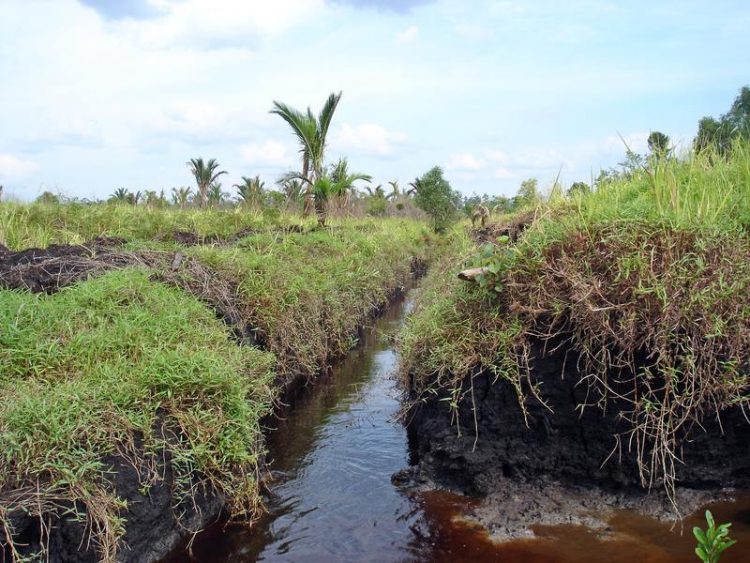Are Southeast Asian peatland rivers really a hotspot of CO2 emissions?

A peat swamp area on Sumatra Tim Rixen, Leibniz Center for Tropical Marine Ecology
Tropical peat swamps are among the most important terrestrial carbon storage ecosystems on earth. A large part of these ecosystems are found in Indonesia and Malaysia. In these countries alone, more than 66 gigatonnes of carbon are stored in the peat swamps – an amount equivalent to eight times the annual global carbon dioxide (CO2) emissions from burning fossil fuels.
However, the increasing deforestation of peat forests in Southeast Asia is putting these sensitive ecosystems under severe pressure: more and more carbon is being leached into the environment. Some of it enters rivers, where micro-organisms release the carbon from its organic compounds and partially convert it to CO2. This CO2 is outgassed from the water surface into the atmosphere where it contributes to global warming as a greenhouse gas.
Scientists of the Leibniz Center for Tropical Marine Ecology (ZMT) and the University of Hamburg have now for the first time measured CO2 emissions from Southeast Asian peatland rivers. The study, which the researchers conducted in cooperation with the Institute of Environmental Physics of the University of Bremen and partners in Indonesia and Malaysia, appeared this week in the prestigious scientific journal “Nature Communications”.
Due to its extensive peat swamps, Southeast Asia was long considered among researchers to be a hotspot of CO2 emissions from rivers – a speculative assumption due to the lack of emissions data from this region. To elucidate the role of Southeast Asian rivers in the carbon cycle, the ZMT researchers and their partners undertook several expeditions to Sumatra and Borneo. There for the first time, within the framework of a research project supported by the Federal Ministry of Education and Research (BMBF), they measured CO2 outgassing from six different peat-draining rivers.
The scientists’ measurements showed that from the rivers under investigation, only a relatively moderate amount of CO2 was outgassed. About half of the carbon sequestered in the peat swamps was emitted into the atmosphere as CO2, the remaining part was transported to the ocean. While the investigated rivers and their catchments emit on average 25 g/m² of carbon per year, the Amazon Basin, in contrast, emits 120g/m² per year – a surprising finding which refutes the previous speculation that Southeast Asia is a hotspot of CO2 outgassing from rivers.
The primary reason for this is the short residence time of dissolved organic carbon (DOC) in the rivers. Most peat swamps are located near the coast, only a short distance from where the rivers flow into the ocean, so that the rivers can only briefly absorb the organic matter. On average, the DOC is only present in the rivers for ten days before it is flushed into the coastal ocean. Therefore, micro-organisms have little time to convert the dissolved organic carbon released from peat into CO2.
However, outgassing of CO2 from carbon can occur in the ocean, too. To which extent the CO2 is emitted into the atmosphere or remains in the ocean is still an unanswered question.
Publication:
Francisca Wit, Denise Müller, Antje Baum, Thorsten Warneke, Widodo Setiyo Pranowo, Moritz Müller and Tim Rixen (2015) The impact of disturbed peatlands on river outgassing in Southeast Asia. Nature Communications.
Contact:
Dr. Tim Rixen
Leibniz Center for Tropical Marine Ecology, Bremen
Tel: 0421 / 23800-55 oder 040 / 42838 7062
Mail: tim.rixen@zmt-bremen.de
About the Leibniz Center for Tropical Marine Ecology (ZMT):
Since 1991 the Leibniz Center for Tropical Marine Ecology (ZMT) has dedicated its research and training to the better understanding of coastal ecosystems in the tropics. The ZMT focuses on the structure and functioning of these habitats, their response to anthropogenic and natural influences and the use of resources. In close cooperation with partners in the tropics, the ZMT leads interdisciplinary projects combining natural and social sciences. Scientists at the ZMT also support the development of expertise and structures in its partner countries to allow for sustainable coastal zone management. In collaboration with the University of Bremen, Jacobs University and the University of Oldenburg the institute trains students and young scientists from all over the world in marine tropical ecology. More than 200 members of staff, students and guest researchers are currently working at the ZMT.
See also: http://www.leibniz-zmt.de
Media Contact
All latest news from the category: Earth Sciences
Earth Sciences (also referred to as Geosciences), which deals with basic issues surrounding our planet, plays a vital role in the area of energy and raw materials supply.
Earth Sciences comprises subjects such as geology, geography, geological informatics, paleontology, mineralogy, petrography, crystallography, geophysics, geodesy, glaciology, cartography, photogrammetry, meteorology and seismology, early-warning systems, earthquake research and polar research.
Newest articles

An Endless Loop: How Some Bacteria Evolve Along With the Seasons
The longest natural metagenome time series ever collected, with microbes, reveals a startling evolutionary pattern on repeat. A Microbial “Groundhog Year” in Lake Mendota Like Bill Murray in the movie…

Witness Groundbreaking Research on Achilles Tendon Recovery
Achilles tendon injuries are common but challenging to monitor during recovery due to the limitations of current imaging techniques. Researchers, led by Associate Professor Zeng Nan from the International Graduate…

Why Prevention Is Better Than Cure—A Novel Approach to Infectious Disease Outbreaks
Researchers have come up with a new way to identify more infectious variants of viruses or bacteria that start spreading in humans – including those causing flu, COVID, whooping cough…



